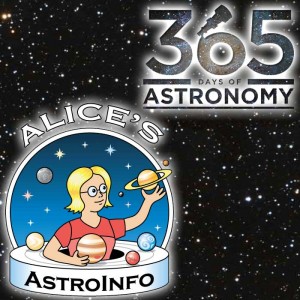Podcaster: Alice Enevoldsen aka Alice’s AstroInfo
 Title: What’s Up Tonight! Southern Skies November 2015 Edition
Title: What’s Up Tonight! Southern Skies November 2015 Edition
Organization: Alice’s AstroInfo
Link : www.alicesastroinfo.com
Heavens-Above Starcharts for anywhere, anytime, not installation required
Stellarium Free planetarium-style program for your computer or tablet
7Timer – Clear sky charts (will it be clear enough for stargazing?). Input your location, then click on “ASTRO” in the pop-up.
Description: Presented as a counterpart to Awesome Astronomy’s Northern Hemisphere monthly forecast, Alice talks about what’s visible from the Southern Hemisphere. Focused at about 33°S, this forecast should work for anywhere between 25°S and 50°S
Bio: Alice Enevoldsen currently volunteers as one of NASA’s Solar System Ambassadors. She has been working in planetariums since 1996, has a B.A. in Astronomy-Geology from Whitman College, and a Masters in Teaching from Seattle University. Her fascination with the stars led her to try her hand at astronomy research in Boston and Walla Walla, where she realized that her calling in life was actually to work in outreach and be a translator for scientists. Now she works hard to share her love of the stars and excitement about astronomy with as many people as possible.
Today’s sponsor: This episode of “365 Days of Astronomy” is sponsored by — no one. We still need sponsors for many days in 2015, so please consider sponsoring a day or two. Just click on the “Donate” button on the lower left side of this webpage, or contact us at signup@365daysofastronomy.org.
Transcript:
Hello, I’m Alice Enevoldsen, coming to you not-so-live from Alice’s AstroInfo with a podcast about what’s up in the November 2015 skies … over the Southern Hemisphere.
How are you today?… Oh good. Well, the rain started here so it is well and truly November. I hope the cyclones and hurricanes are avoiding you so you can enjoy the sun.
Top News and Sky Objects this Month:
We’re getting ready for the Leonid Meteor Shower. The peak night is Nov 17-18, look in the Northeast between midnight and sunrise. We also still have the Taurid meteor showers going on, producing not as many meteors, but those that are produced are more likely to be bolides (fireballs).
As I mentioned last week, comet C/2013 US10 (Catalina) is brightening up a bit. It’s predicted to be magnitude 6 in November and 5 in December, which means you’ll still need a Telescope or Binoculars. You’ll be looking in the southeast just before the Sun rises. It’ll be moving from constellation Libra into constellation Virgo, and look like a fuzzed-out star.
For “Hey What’s That?” Jupiter, Mars and Venus are all arrayed before sunrise still. The highest bright object is Jupiter, and the closest to the horizon is Venus. Sirius is also rising shortly after sunset, and it’s so glittery and sparkly it is often mistaken for a UFO.
Let’s cover the Moon Phases, dates adjusted for Sydney, Australia.
The day of the new moon will be November 12th, and on that day you won’t see the Moon at all, but a day before or after you might see a tiny sliver of a crescent Moon as the Sun rises or sets, and a few days outside of that the Moon will be up all day.
The first quarter moon, November 19th, is ideal for late afternoon and early evening observation.
The next full moon will be November 26th. It rises around sunset, and sets around sunrise.
The last quarter moon on December 3rd will be visible in the early morning sky.
The lineup of early Evening Constellations gains Orion, Taurus, Canis Major, Lepus, and Columba.
You can download a nice Southern Hemisphere starmap from Skymaps.com.
Well! Thanks for tuning in: I hope I gave you some things for which to keep your eyes peeled.
For those of you who haven’t listened before, I’m here as a foil for Ralph and Paul with Awesome Astronomy and their monthly 365 Days of Astronomy, International Year of Light podcast about what’s up in the skies over the Northern Hemisphere.
This podcast is based at 33°S: times and dates are given for Sydney, Australia. Most information will be good anywhere from about 25°S to 50°S, though you may have to adjust the time zone. This will include major cities in Australia, New Zealand, countries in Africa south of Mozambique and Namibia, as well as the parts of South America south of Paraguay.
I’ll add some of my favorite planning links to the end of the transcript for you as usual. If you have suggestions, things that you’d like me to add to the “What’s up Tonight, Southern Skies Edition,” you can e-mail me from my website!
Once again, I’m Alice Enevoldsen. You can find me online as AlicesAstroInfo on Twitter, Facebook, and www.alicesastroinfo.com.
Bye! See you later!
Useful Links:
Heavens-Above Starcharts for anywhere, anytime, no installation required
Stellarium Free planetarium-style program for your computer or tablet
7Timer – Clear sky charts (will it be clear enough for stargazing?). Input your location, then click on “ASTRO” in the pop-up.
Monthly Sky Guides from Sydney Observatory
End of podcast:
365 Days of Astronomy
=====================
The 365 Days of Astronomy Podcast is produced by NUCLIO. Audio post-production by Richard Drumm. Bandwidth donated by libsyn.com and wizzard media. You may reproduce and distribute this audio for non-commercial purposes. Please consider supporting the podcast with a few dollars (or Euros!). Visit us on the web at 365DaysOfAstronomy.org or email us at info@365DaysOfAstronomy.org. This year we celebrate cosmic light as light is our info messenger in the universe. Join us and share your story to celebrate the International Year of Light. Until tomorrow! Goodbye!

